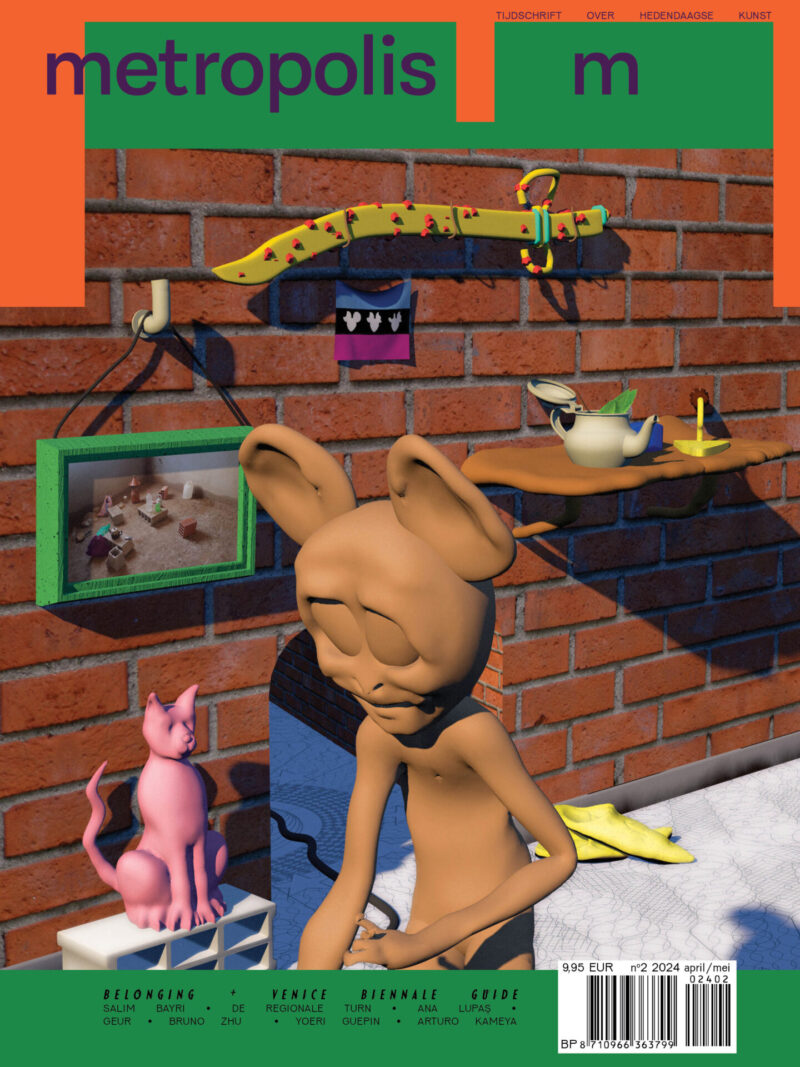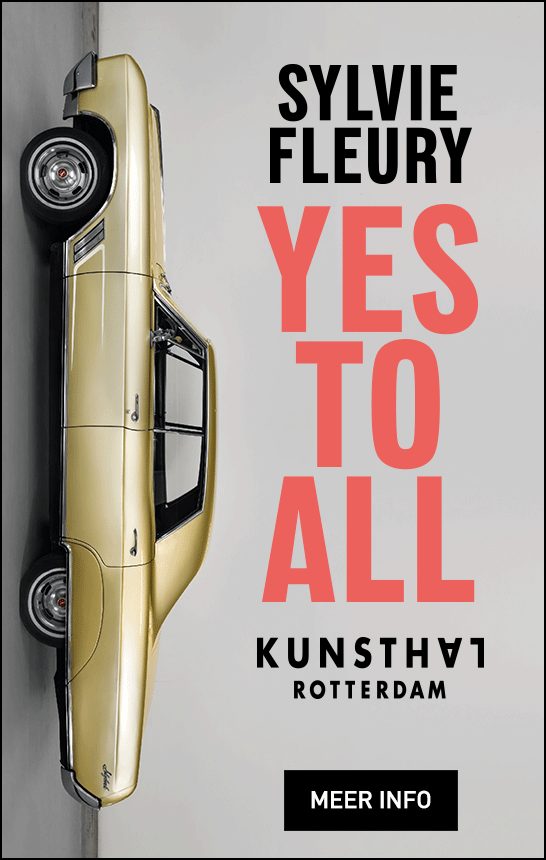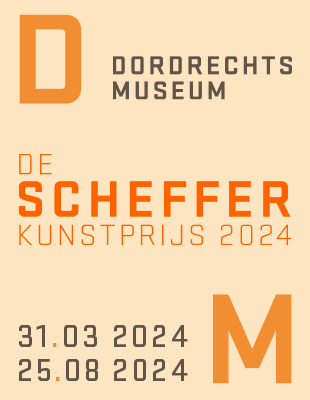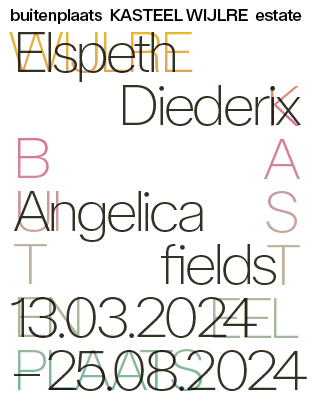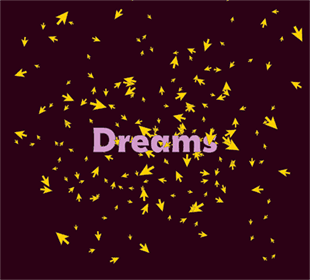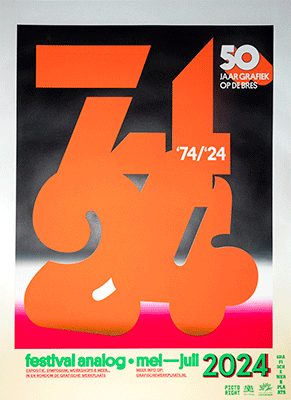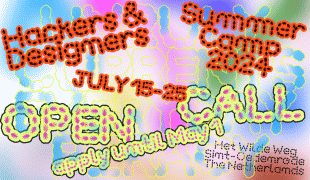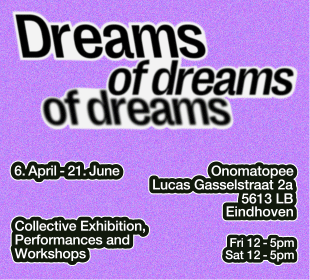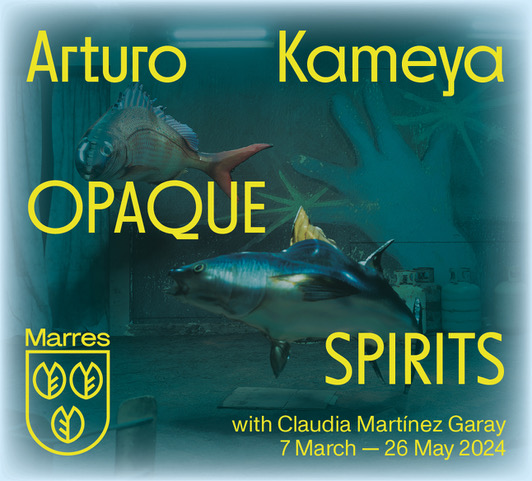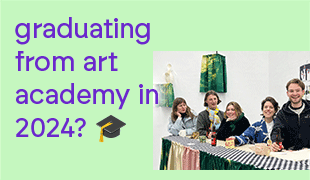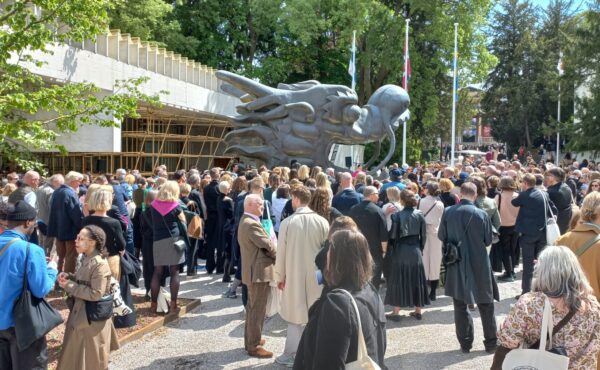
Caz Egelie, She’s been in the bizz for years, 2018, courtesy Palais de Tokyo, picture Chaïm Dijkstra
Repositioning the audience – in conversation with Caz Egelie
Brightly coloured shapes, absurdist costumes referencing both fashion and art history, geometric abstraction, animation and brilliant red fingernails that poke-up from the floor; all can be found in the works of the artist Caz Egelie (1994). Egelie’s art practice employs performance, theatre, costumes, found clothing and objects, sculptures and two-dimensional works. Together, these gestures form carefully arranged installations, or rather: scenes, patiently waiting to be activated by the viewer.
During our interview on zoom, Egelie explains that through their work they want to broaden the audience perception of culture and history – and for that matter, history in general – as they create a space for nuanced understandings of what ‘truth’ can mean. Egelie enjoys walking the fine line between fact and fiction in their work, often tempting their audience to question historical truth and narratives to create a space of possibility. For them, questioning notions of authenticity and the relevance of this particular facet of the art system was how they found their own voice as an artist. “What has art history been about, and how do I relate to all these people who have come before me? Particularly as a person, but also as a ‘young’ artist?”
Still common in the art world is the sense that all ideas must be original and authentic to have value. Egelie’s practice, inspired by a wide range of ideas and disciplines (theatre, film, fashion, history, and so on), breaks with that tradition. In its place, the artist poses a question: what are the things that exist and that already inspire us, and how can we build on that? Egelie: “This traditional idea of the artist having to come up with a lot of things by themselves, as a sort of genius, is outdated to me, because we are so connected to everything in society right now, with things like the internet and knowing people all over the world. It doesn’t make sense to think of the artist as an individual or source of genius that anything and everything can sprout from, there is so much influential input going in that you are always related to something else.”
[blockquote]Egelie enjoys walking the fine line between fact and fiction in their work, often tempting their audience to question historical truth and narratives to create a space of possibility

Caz Egelie, The Gallerist, 2018, courtesy Palais de Tokyo, picture Ayka Lux
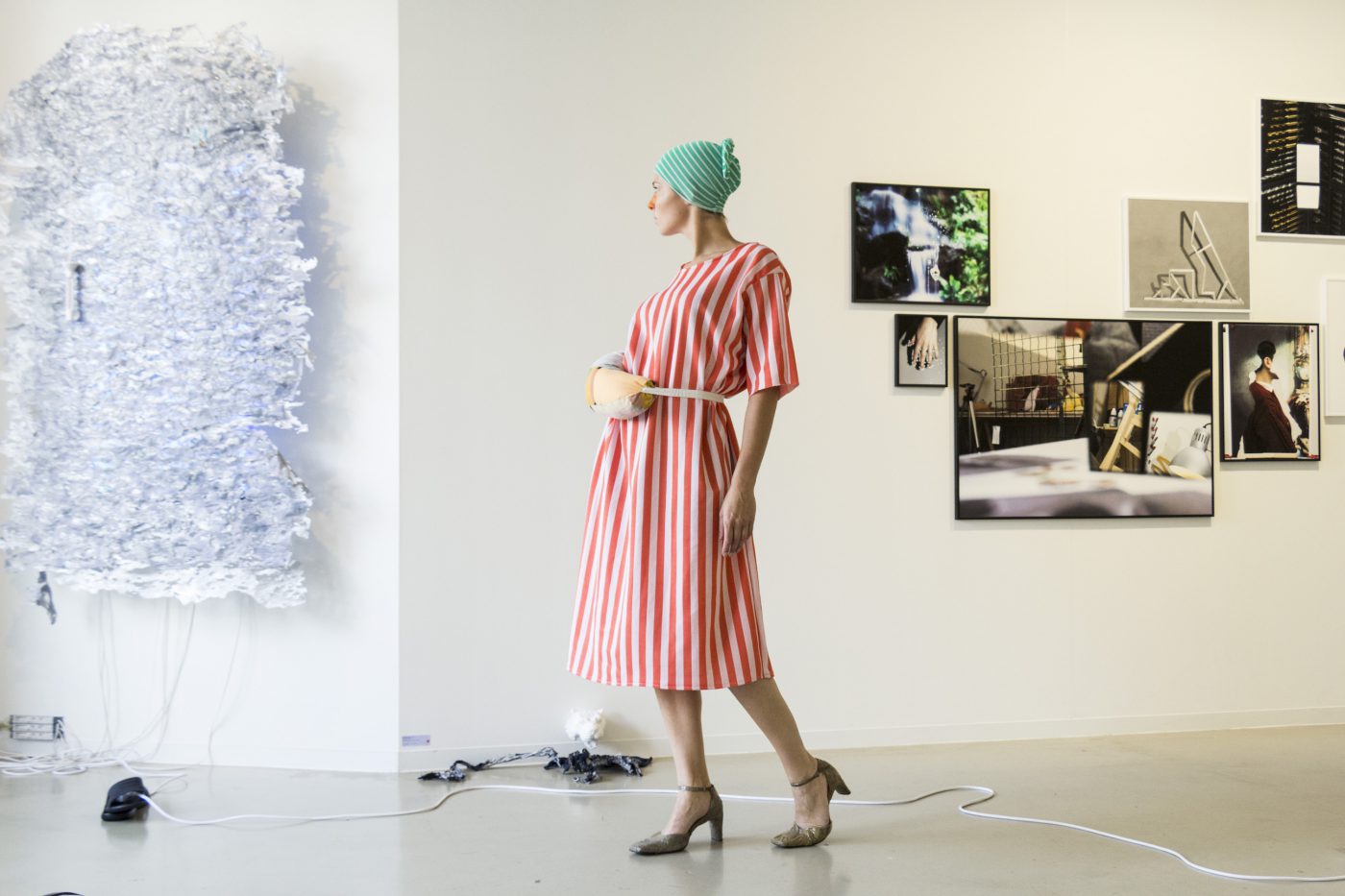
Caz Egelie, I've seen that face before, 2017, courtesy Ron Mandos Gallery, picture Bart Lunenburg, work in background by Vytautas Kumža and Martin Brandt
RUTETINTROOTH (2017), Egelie’s brightly coloured graduation work, is an example of how the artist tries to position themselves in the art field. The title is a play on the words rooted-in-truth meaning ‘based in truth’ and comes from a misunderstanding the artist had while listening to the sculptor Michael Dean. This play on words also links to Egelie’s interest in pointing our that art history has often carried the trait of having to be ‘rooted’ in reality and fact, something the artist wishes to push back against in their work. This installation includes references to Lewitt, Hepworth, West, Oldenburg and Wesselman and Egelie appropriates the works of these famous artists in various ways; but adds their own touch to the piece by increasing the scale of a work for example. “There are so many hidden layers to the work which don’t reveal themselves if you just look at the work for a few minutes, so I try by using these really bright and colourful aesthetics to trigger something in the audience that they feel like they want to do more research into what they are looking at.” There are always multiple layers to be found in Egelie’s appropriations. In a black and white geometric abstraction, for example, which seems like a Frank Stella painting but actually is a work by fictional artist Hank Herron, Egelie reenacts the with postmodern notions of pastiche, parody, truth and fiction. Egelie essentially gives the audience clues with elusive links, prompting them to ask more about a work to spark their curiosity.
Singling out symbols, characters, and motifs in the work of well-known artists from the 20th century, in RUTETINTROOTH Egelie recontextualises each reference into reformations and new configurations. It is as if a group performance is being staged; everything unfolds as an interrelating network, and at times a performer in costume may be present to further enliven the space and installation. Importantly though, the work only really comes to life via an audience experience that Egelie refers to as the modern realist theatre convention of dissolving ‘the fourth wall’.
Singling out symbols, characters, and motifs in the work of well-known artists from the 20th century, in RUTETINTROOTH Egelie recontextualises each reference into reformations and new configurations
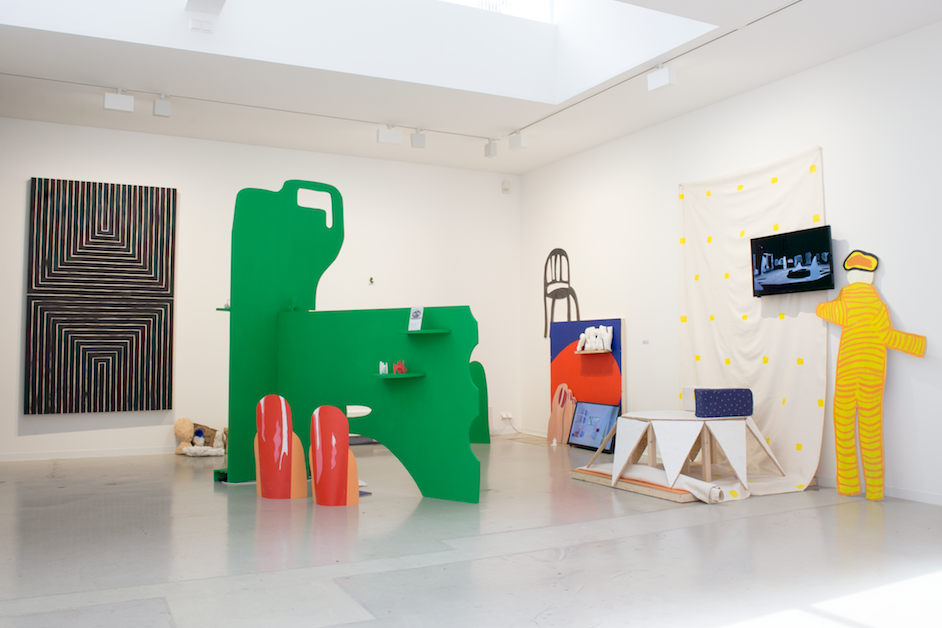
Caz Egelie, RUTETINTROOTH, 2017, courtesy Ron Mandos Gallery, picture by Annabelle Binnerts
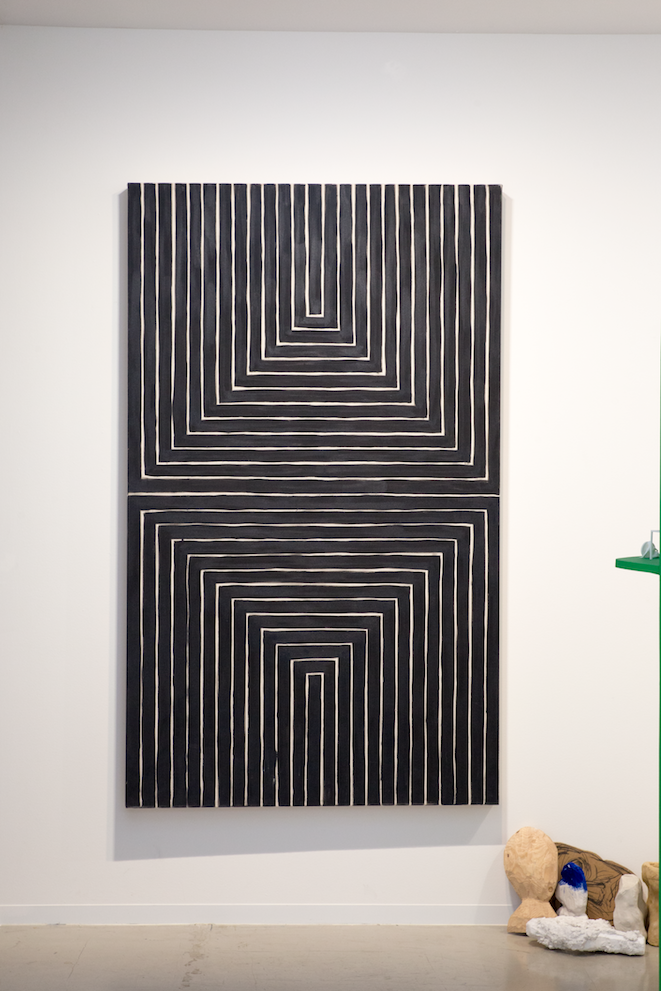
Hank Herron, Arundel Castle, 1970, courtesy Ron Mandos Gallery, picture by Annabelle Binnerts
Egelie tells me about how RUTETINTROOTH marked the first time they worked with performers. During the work’s development, Egelie posted ‘Wanted’ advertisements for dancers. “I looked at the installation and it sort of felt all dead to me. It was all just standing there, and then I realised I had to work with a performer to activate the space and also maybe give the audience an example of how to possibly move through this space.” Egelie has worked with all kinds of performers, but in this situation, the performance was held by dancer Jelina de Raad, who moves around the space in a way “reminiscent of Bob Fosse”, the American choreographer. This work has also travelled and been shown as various renditions at Ron Mandos Gallery in Amsterdam as well as in the National Gallery Prague, Arti et Amicitae and AG in Utrecht. They explain: “For every installation I would make a selection of all the works because, sometimes the work would be in two places at the same time, and I would make a new structure at another place.” This way of displaying the work in a mutable way also gave the artist freedom to create installations that linked with one another from varying locations, acting as props and communicating across time and distance.
Egelie talks me through their practice with a smile, humour is important to the artist. There are various humorous ‘characters’ present in their work, often mirroring the art world back on to itself, and potentially counter balancing the hierarchies that permeate most creative spaces. “I always like to think of like myself as the jester in this medieval period of time in which they are the one inside the castle but who is still allowed to poke fun at the king.” One character prominent in Egelie’s performances regularly and who has evolved over time is The Critic. The Critic has made appearances in performances such as The Greatest Art Lover of All Time (2017), The Critic and the Collection (2017) and Something’s coming As performed by the Critic (2020) and on show at Palais de Tokyo in Paris, Centrale Brussels and Open Space in London. Egelie: “The character is a bit of a comment on the traditional idea of an art critic – displaying their power through commenting on the works of others. The most recent costume for the critic is based on a Maison Margiela collection[1] in which images of clothes are screen printed on other clothing items.” This can be seen in Egelie’s performance in Brussels The bat of one lash (2021) as a black and white printed garment, underwear set and wrap skirt, which the artist wears them self during the performance. This dynamic character makes multiple gestures in a cross-disciplinary way, joining together art-historical, sociological and fashion narratives.
There are various humorous ‘characters’ present in Egelie's work, often mirroring the art world back on to itself, and potentially counter balancing the hierarchies that permeate most creative spaces
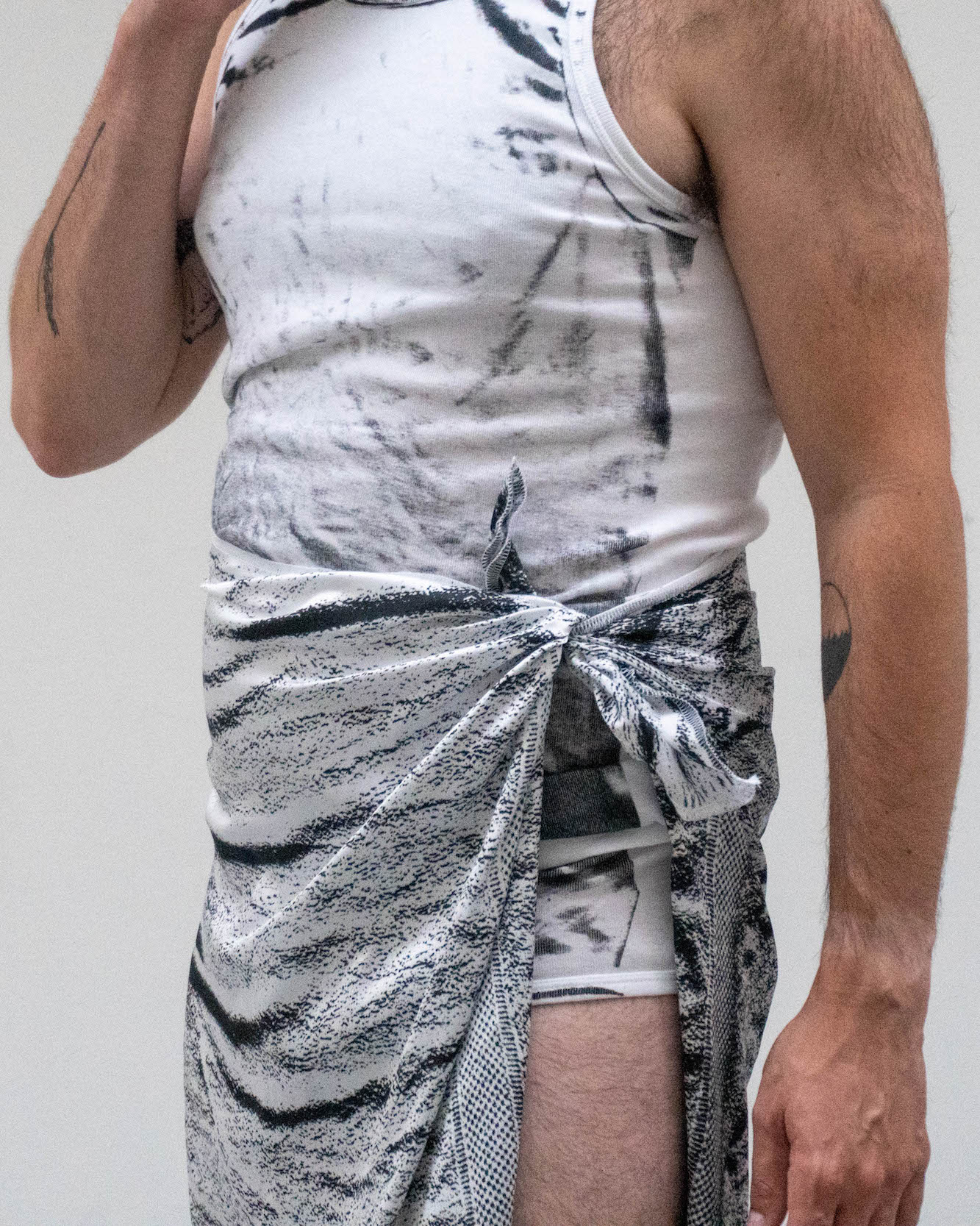
Caz Egelie, Costume for The Gallerist, 2021
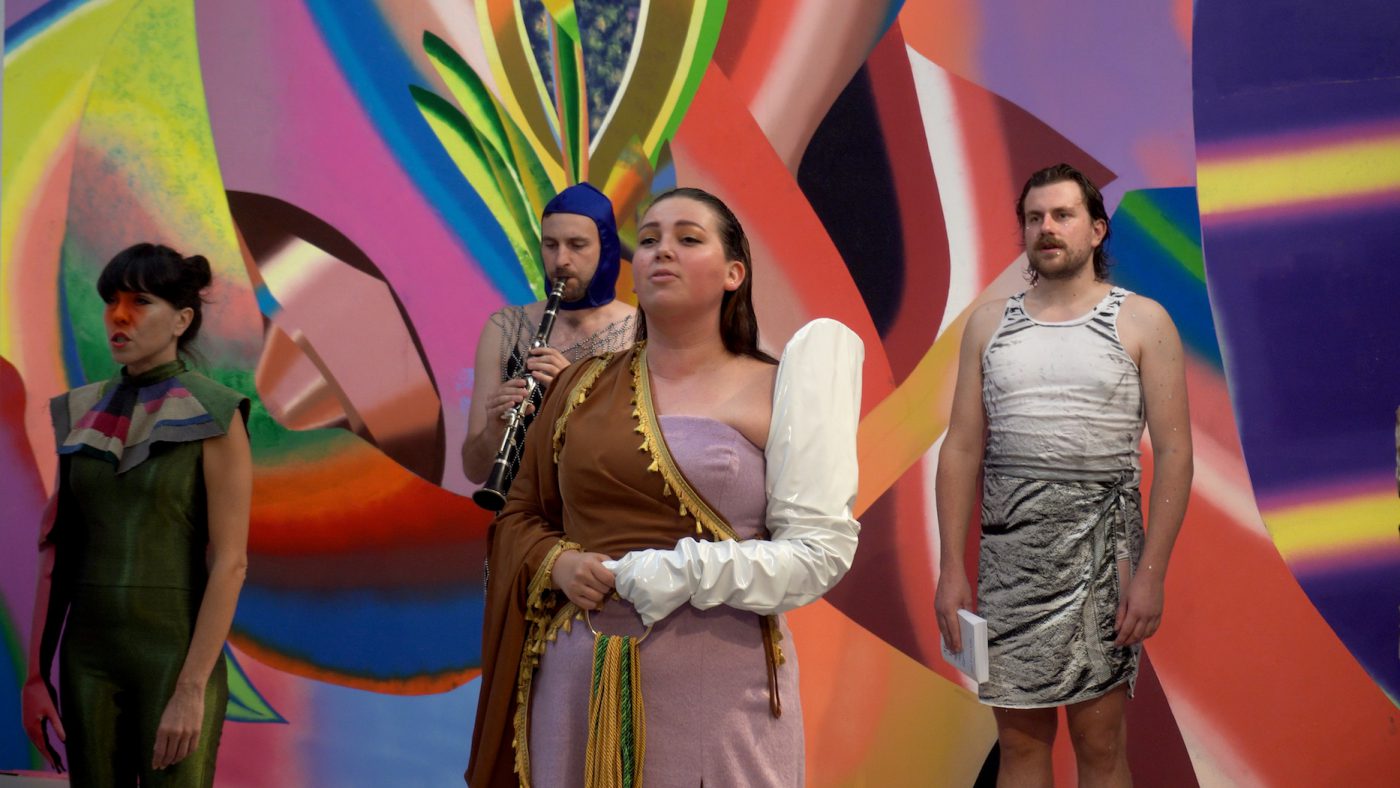
Caz Egelie, The bat of one lash, 2021, courtesy Centrale Brussels, work in the background by Hadassah Emmerich
In their broader installations, Egelie fluidly brings different elements together, involving performers, students and the public creating a ‘happening’ where the work refuses to be contained and categorised as one thing. This collaborative way of working is partly informed by their work as teacher. After studying art education and Fine Art at the HKU in Utrecht, Egelie now teaches in both the Education department at ArtEZ in Arnhem and the Fine Art department of the HKU.
During our conversation, they tell me about how it was actually a love for fashion, rather than for art and education, that initially drew them to the art academy: “When I was still in high school, there was no doubt I wanted to become a fashion designer.” After visiting art schools and their various fashion departments in the Netherlands and Belgium, however, it was contemporary art and education that really sparked their enthusiasm: “I was just walking through the school, and I noticed that the students were doing so many different things at the same time; they were painting, making sculptures, doing performances, and making video … that got me very excited, and I suddenly thought if I follow the fashion studies dream, I feel like I’m going to limit myself by doing things which always have to be related to the body in some way … and walking into the art school I felt like I just wanted to explore everything.” Still, Egelie’s work frequently features something to do with the body, bringing to light their initial interest in fashion.
“When I was still in high school, there was no doubt I wanted to become a fashion designer”
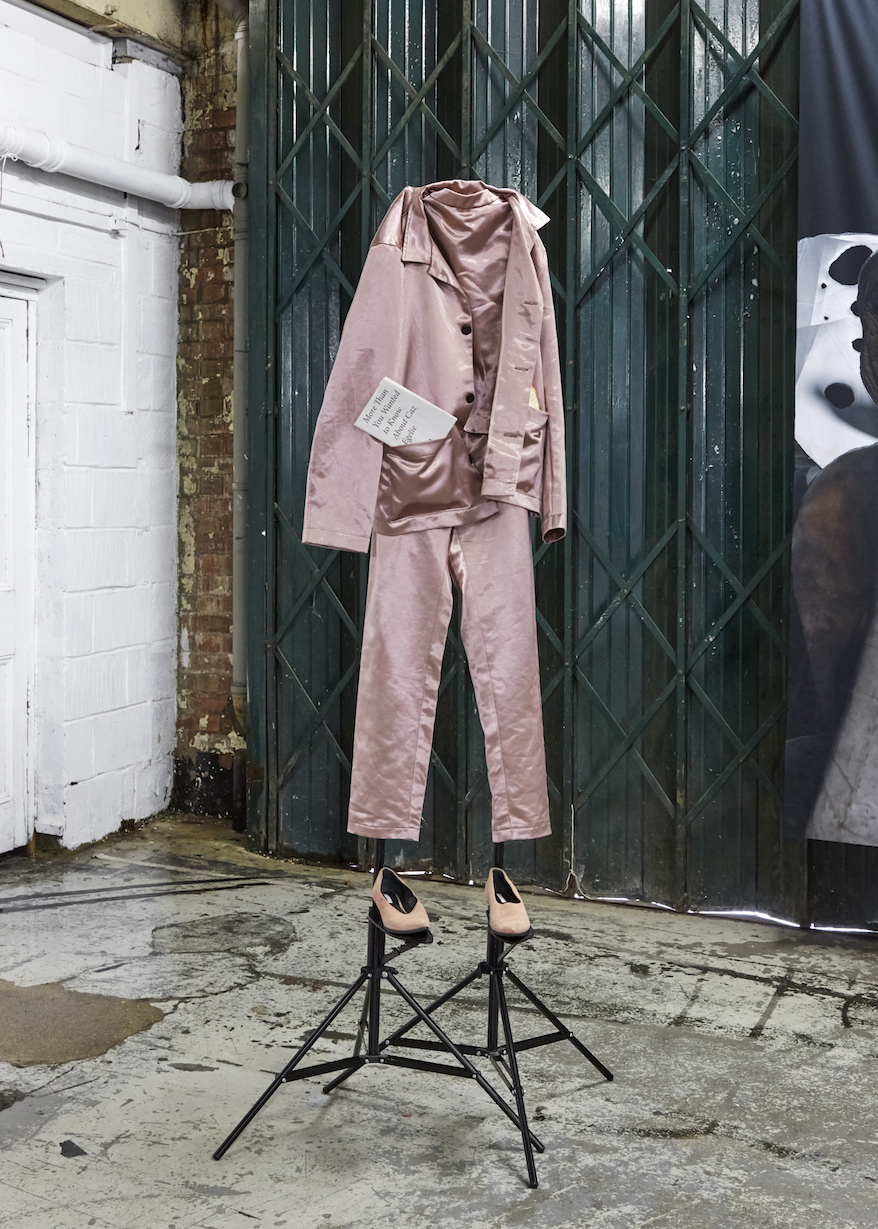
Caz Egelie, Costume for The Critic, 2018, courtesy Open Space London, picture Sam Nightingale
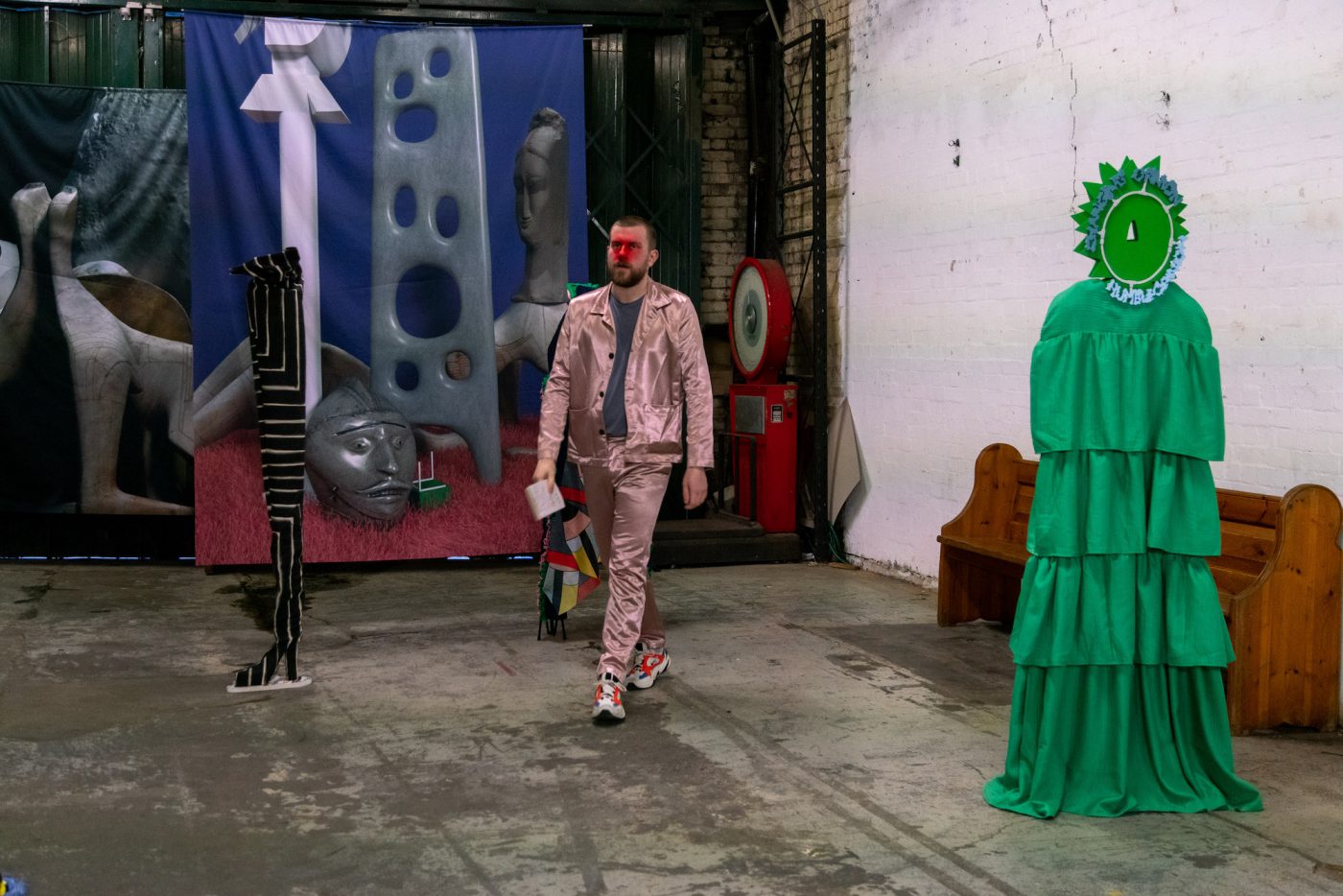
The Critic, something's coming, 2020, courtesy Open Space London, picture Sam Nightingale

The Critic, It may come cannonballing down from the sky, 2020, courtesy UtrechtDownUnder, picture Edo Verhoeff
Growing up, their experience of modern and contemporary art was slight until a family visit to Moderna Museet in Stockholm, where Egelie stumbled upon an exhibition titled Explosion! (2012), which explored painting and its relationship to the body through the work of well-known 20th century artists like Allison Knowles, Lynda Benglis, Lawrence Weiner, Yoko Ono and the Gutai group. The group show investigated painting via the sense of performance, and how this presented artists with a world of new possibilities. “It was all about painters who used movement and bodily actions as a means to put something on canvas or make a ‘painting’ –in the broadest sense of the word. There were also Fluxus performances present in the space, and all works could be combined with one another, investigating a really contemporary way of working. That’s when I first felt very connected to modern art.”
Later, the artist’s practice was further enhanced through – amongst other things an internship at the Van Abbemuseum – confronting point of view in art history and artworks considering things like queer point of view and feminism. This is particularly around how an artwork can be approached and understood in various ways which are otherwise not typically highlighted. “It became really clear that an artwork’s themes aren’t only present in the content of that work but could also be in the action – so how you are approaching or experiencing things. You can invite people in, make things more open-minded or the methods of working can also be queer or feminist, but a specific theme doesn’t have to be queer or feminist. Summarising this, it’s also possible to approach other themes in a queer or feminist way.”
Egelie has explored this way of working even more in recent years. During the group exhibition at Garage Rotterdam What If Women Ruled the World (2019), they investigated the question of what the world would be like if it was dominated by an increased feminine influence through performance and costume. This exhibition built on ideas often part of Egelie’s broader point of view, considering not a world where men and masculinity aren’t present but more so, what if we don’t have to approach identity from a gendered perspective. This is a clear example of how Egelie plays with the notion of presenting a more nuanced and plural space, which builds on the lineal space in art history currently existing. Egelie tells me: “Working on shows like these has helped me understand my own exploration of identity and that queerness and feminism can very well be a part of my practice.”
“Working on shows like What If Women Ruled the World (2019) has helped me understand my own exploration of identity and that queerness and feminism can very well be a part of my practice”

Caz Egelie, The Greatest Art Lover of All Time, 2017, courtesy Palais de Tokyo, picture Ayka Lux
This year Egelie is working on a performance to take place at the sculpture garden in Tilburg, LUSTWARANDE. The artist has been invited to create an intervention that responds to the sculptural exhibition, consisting of a solo theatrical performance and costumes, but also of smaller accompanying performances spread out throughout the park. For this, Egelie is exploring a more spontaneous audience-performance interaction, and really considers how can they get through to their audience sparking curiosity to do more research in to what they are actually experiencing. Working without a performance schedule, the unexpected pops-up has been one strategy for this in the past to engage the audience in elements of surprise. During LUSTWARANDE Egelie wants to play with the idea of the audience and voyeur, through creating spontaneous popup performances which appear as a private moment between performers throughout the park. Stumbling on these happenings, the audience is asked to reflect on their own spectatorship. Reflecting on the role of the audience Egelie says: “Perhaps this is the influence of education on my practice, but the audience is always tasked with trying to piece the work together, becoming curious about the artist behind the work but also about art history at the same time.”
In 2022, Caz Egelie’s performance at LUSTWARANDE is planned for July 10th and they also have an exhibition they are working on with FP/SB (an Utrecht art initiative initiated by Jesse Strikwerda and Caz), curated by Sarah Klevan at Kunstliefde in Utrecht coming up opening on March 5th called The Spatial Analogy and No One Without the Other.They will also participate in The Bosch Parade in June.
[1] Maison Margiela, 1996, Spring Ready-to-wear, https://www.vogue.com/fashion-shows/spring-1996-ready-to-wear/maison-martin-margiela
Alyxandra Westwood
is an artist, writer and curator and is based between Utrecht and Melbourne